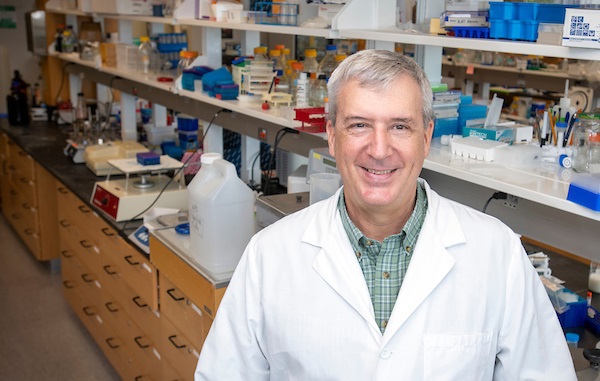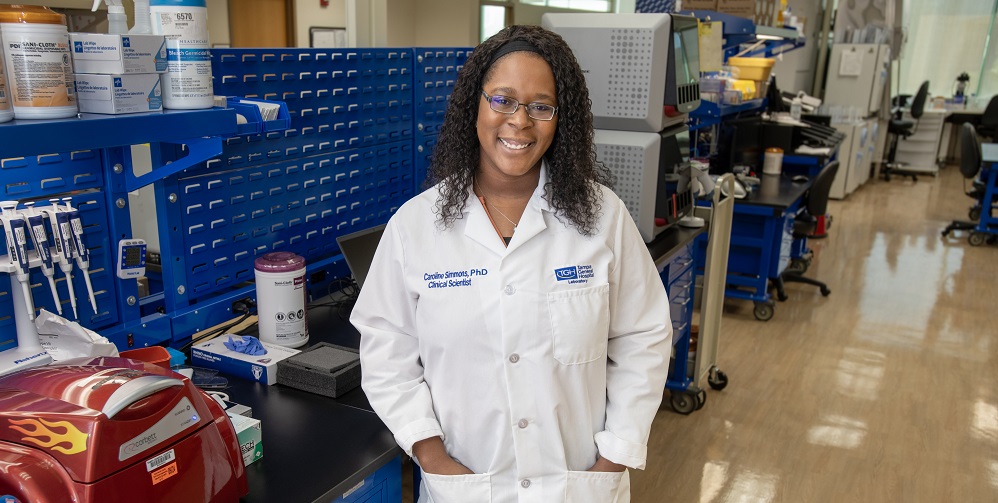It has the sound of a Hollywood movie – including mutants and deadly parasites that develop an alarming resistance to traditional means of containment, threatening to overtake populations on two continents.
But this is no summer popcorn flick. It’s how malaria is actually spreading in Africa and many parts of Southeast Asia. The mosquito-driven disease has grown increasingly tolerant to traditional drug treatment, with potentially devastating consequences, particularly to children.
Enter two USF Health researchers: distinguished USF professor John Adams, PhD, director of the USF Genomics Program and co-director of the Center for Global Health and Inter-Disciplinary Research; and a member of his lab, clinical scientist Caroline Simmons, PhD – newly anointed with her medical sciences doctorate in the areas of genomics, drug resistance and infectious diseases.
She served as lead author and Dr. Adams as senior author, along with nine other USF Health researchers, in a recently published study analyzing novel factors that can alter a malaria parasite’s response to drugs – particularly significant given the parasite’s increasing drug resistance, leading to treatment failure.
The importance of their work is even more clear now, following the diagnosis this summer of seven Florida residents infected with malaria that was transmitted by mosquitoes in Florida, as well as another case in Texas. These are the first locally transmitted cases of malaria infection in the U.S. in 20 years.
Dr. Simmons was a fifth-grader when Dr. Adams published his first study on a new tool for forward genetics research in malaria in 2005 – two years prior to joining the USF College of Public Health’s Infectious Research Program. He had worked the previous 16 years at the University of Notre Dame, building on his training in basic parasitology and molecular approaches to malaria at the National Institutes of Health.
“I joined the Morsani College of Medicine PhD program and had the chance to rotate between three labs,” said Dr. Simmons, who earned her undergraduate degree in Microbiology and masters in Medical Sciences from USF as well. “And Dr. Adams was one of the labs I decided to join – he was doing amazing work on malaria. I’ve always found drug-related issues interesting, and I love working on things that have an impact on people. I started out just rotating in his lab, and then I decided to join.”
Now they have teamed up to create a major advance in the understanding of malaria’s resistance to artemisinin or artemisinin-based combination therapies, known as ACTs – the drug used to cure and treat the malaria-infected parasite.
And they’ve done it with what you might liken to a different Hollywood approach – Back to the Future. Essentially, through a study she conducted, Simmons found a way to go back to an earlier time point in a parasite’s normal development, disrupting it in a manner that makes it less effective in tolerating artemisinin or ACTS – but more on that in a moment.
First, some important background in the progression of events: In 2015, the Nobel Prize in Physiology or Medicine was awarded to Chinese scientist Youyou Tu for her key contributions in the discovery of artemisinin as the active ingredient in a traditional herbal medicine.

“It was such a great discovery, but it has some limitations,” said Dr. Adams. “It’s a fast-acting drug but it also disappears very quickly. There are various older drugs it’s partnered with, and what happens when the artemisinin portion disappears, there’s a resistance to the partner drug. At the same time, the parasite has slowly evolved. It just has to hang around long enough not to get killed by artemisinin, which disappears so fast. And if the parasite is in the early phase of its development, it has a natural resistance to the drug.”
That is what has led to the unfolding, new crisis in Africa and Southeast Asia, where malaria has begun to take hold once again, raising fears of a new global health emergency.
• • •
What happens to the body when a person contracts malaria? Dr. Adams explained that the parasite enters the red blood cells, where it finds a “food” source in the form of hemoglobin, which carries oxygen through the bloodstream.
“It’s a protein, but in the center of the protein is an iron molecule, which carries oxygen,” Dr. Adams said. “The protein is there to hold the iron in place, and not allow it to interact with anything else. But when the parasite eats the protein part, it releases the iron, which is very toxic. The release of this iron activates the artemisinin. But the parasite now has an increased resistance to the drug, basically resulting from a slowed-down ingestion of the hemoglobin. By slowing down, the parasite is better equipped to deal with the effects of the fast-disappearing drug. All the parasites in Southeast Asia now carry this mutation.”
The outward manifestation of malaria often portrayed in the movies, said Dr. Adams, is of a person shaking and sweating in some subtropical bed. “That’s what is known as malaria fever, which happens every 48 hours,” he said. “The parasite is synchronized in its growth, so all the stages in the blood are maturing at the same time. When they finish, they rush out of the cell, so there’s all this garbage released into the circulatory system, and that induces a shock response. The person feels cold, but they have an intense fever that can last four or five hours.”
The fact that the parasite could survive the intense fever when it enters the cell intrigued Dr. Adams and Dr. Simmons.
“We were curious why it was not dying under these extreme temperatures,” he said. “We discovered that these are the same genes people are seeing with drug-resistant parasites. And they’re the same genes we’ve already started to identify in these other screening methods. So the parasite has evolved over the years to survive fever – and now artemisinin.”
• • •
Dr. Simmons’ work with Dr. Adams was recently featured in Johns Hopkins University’s “Malaria Minute Extended” podcast, explaining how she has gained a greater understanding of which genes are responsible for artemisinin resistance. She did that by creating mutants of the malaria parasite, with certain genetic elements inserted into the genome – known as “transposons.”
“We’re pretty familiar [with the idea] that genes play an important role in how organisms respond to different stimuli,” she told the host. “So with transposeons, these are mobile genetic elements – essentially chunks of genes that can be inserted at different points through the genome.” These gene-disrupting insertions often cause a loss of function of the affected gene.
For her study specifically, and in many of the mutants analyzed in the lab, Dr. Simmons called these clusters “single insertion piggyBac transposon mutants.” And they provided a key to unlocking the mystery of the parasite’s increased drug resistance. She was able to take these mutant genes and screen them against artemisinin, and observe how the parasites respond to drugs.
Through that process, Dr. Simmons learned that seven genes have increased drug sensitivity – one of which is called KIC5. When she researched the gene for her dissertation, the gene’s function was considered unknown. But a research group in Germany later found a connection between KIC5 and a Kelch 13 protein, also linked to artemisinin resistance. That was a step forward. And Dr. Simmons soon began a deeper dive with the KIC5 gene, on the verge of a breakthrough.
While other parasites showed a tolerance to artemisinin, the KIC5 mutant parasite did not. Here’s where a bit of “time travel” came into play. The KIC5 gene she inserted in a mutant parasite altered the time point of that parasite’s development. That essentially made it impossible for the parasite to have a normal metabolism, delaying its ability to recover and adapt to the stress induced by artemisinin.
“It’s unable to have a normal response when it encounters artemisinin,” she said. “In fact, it’s an abnormal response, causing the parasite to be more sensitive to artemisinin.”
Dr. Adams likened the parasite’s response to throwing a pebble in a pond, and watching the ripples that result.
“We look at where the ripples occur through the parasite development,” he said. “The parasite development is very rhythmic, with a cascade of genes that are turned off and on in a predictable manner. A lot of genes are expressed just in time for when they’re needed, and then they’re gone. So if they are made at the wrong time, they will not have the same function as they did. In the case of KIC5, the parasite survived, but it was enough to make it different than its normal type.”
Much research remains to be done. But with the KIC5, USF Health has moved the study of malaria-infected parasites forward – by turning back their internal clock.
- Photos by Allison Long, USF Health News
